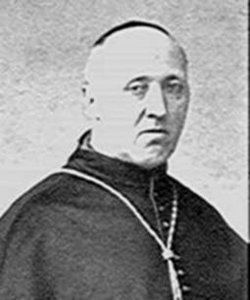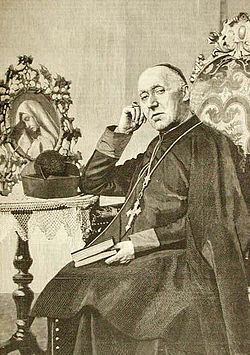Buried Cathedral of Milan See Milan Name Luigi di Consecration June 6, 1847 | Appointed March 27, 1867 Role Politician Ordination May 29, 1831 Term ended October 23, 1893 | |
 | ||
Other posts member of Italian Senate Born July 27, 1808Savigliano ( 1808-07-27 ) Died October 23, 1893, Milan, Italy Place of burial Milan Cathedral, Metropolitan City of Milan, Italy | ||
Luigi Nazari di Calabiana (1808 – 1893) was an Italian churchman and politician: a senator of the Kingdom of Sardinia and Archbishop of Milan.
Contents

Bishop of Casale and Senator
He was born on 27 July 1808 in Savigliano to Filippo, count of Calabiana, and the noblewoman Sofia Toesca of the counts of Castezzo. On 18 March 1847 he was appointed Bishop of Casale Monferrato by Charles Albert of Sardinia and consecrated bishop on 6 June 1847 in Rome by Cardinal Ugo Pietro Spinola. As bishop of Casale he was involved in the successful campaign to save its ancient Romanesque cathedral from demolition.
On 3 May 1848 he was nominated as senator by king Charles Albert, taking the oath on 22 May of that year. He unsuccessfully opposed Siccardi reforms of 1850, which were intended to revoke certain ancient privileges which the Catholic Church enjoyed in Piedmont, and he led the opposition to further reforms in 1855, intended to institute a ‘free church in a free state’, provoking the Calabiana crisis which forced the resignation of Cavour, although again the legislation was passed into law.
Archbishop of Milan
In 1867 he was named by Pope Pius IX archbishop of Milan, and his appointment solved the crisis in such important and large diocese. Actually the previous archbishop Paolo Angelo Ballerini of Milan had been suggested by the Austrian emperor, but he was not allowed to enter in the town by the Kingdom of Sardinia that took possession of the Lombardy after the Second Italian War of Independence. So with the appointment of Nazari di Calabiana Milan again had a residence bishop. In the frame of the hostility between the Holy See and the kingdom of Sardinia (later Kingdom of Italy), Nazari di Calabiana was considered to be on conciliatory positions, while the previous archbishop Ballerini, who during Nazari's reign resided in Seregno near Milan, remained a fierce opponent of the Reign. Nazari di Calabian was never created cardinal.
As Archbishop of Milan, Nazari di Calabiana is remembered for his social activity, for the erection of new churches in the suburbs of the town and for the discovery of the relics of Saint Ambrose and Gervasius and Protasius founded in an old sarcophagus buried under the altar of Basilica of Sant'Ambrogio. At the First Vatican Council he was the leader of the minority of Italian bishops who opposed the introduction of the doctrine of Papal Infallibility, but after the proclamation of the dogma he promptly undersigned it. Luigi Nazari di Calabiana died in Milan on 23 October 1893.
